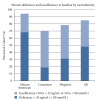Profound Vitamin D Deficiency in a Diverse Group of Women during Pregnancy Living in a Sun-Rich Environment at Latitude 32°N
- PMID: 21197089
- PMCID: PMC3004407
- DOI: 10.1155/2010/917428
Profound Vitamin D Deficiency in a Diverse Group of Women during Pregnancy Living in a Sun-Rich Environment at Latitude 32°N
Abstract
Objective: Determine prevalence of vitamin D deficiency (VDD) in a diverse group of women presenting for obstetrical care at two community health centers in South Carolina at latitude 32°N.
Methods and design: Any pregnant woman presenting for care at 2 community health centers was eligible to participate. Sociodemographic and clinical history were recorded. A single blood sample was taken to measure circulating 25(OH)D as indicator of vitamin D status [25(OH)D < 20 ng/mL (50 nmol/L deficiency; <32 ng/mL (80 nmol/L) insufficiency]. Total serum calcium, phosphorus, creatinine, and intact parathyroid hormone also were measured.
Results: 559 women, [mean age 25.0 ± 5.4 (range 14-43) years] participated: African American (48%), Hispanic (38%), Caucasian/Other (14%). Mean gestational age was 18.5 ± 8.4 (median 14.6, range 6.4-39.6) weeks' gestation. 48% were VDD; an additional 37% insufficient. Greatest degree was in the African American women (68% deficient; 94% insufficient). In multivariable regression, 25(OH)D retained a significant negative association with PTH (P < .001).
Conclusions: VDD was high in a diverse group of women, greatest in those of darker pigmentation. The negative correlation between 25(OH)D and PTH confirms their corroborative use as biomarkers of VDD. These findings raise the issue of adequacy of current vitamin D recommendations for pregnant women.
Figures
Similar articles
-
Vitamin D deficiency and insufficiency is common during pregnancy.Am J Perinatol. 2011 Jan;28(1):7-12. doi: 10.1055/s-0030-1262505. Epub 2010 Jul 16. Am J Perinatol. 2011. PMID: 20640974
-
High prevalence of severe vitamin D deficiency during the first trimester in pregnant women in Switzerland and its potential contributions to adverse outcomes in the pregnancy.Swiss Med Wkly. 2020 May 28;150:w20238. doi: 10.4414/smw.2020.20238. eCollection 2020 May 18. Swiss Med Wkly. 2020. PMID: 32502277
-
Suppression of Parathyroid Hormone as a Proxy for Optimal Vitamin D Status: Further Analysis of Two Parallel Studies in Opposite Latitudes.Nutrients. 2020 Mar 28;12(4):942. doi: 10.3390/nu12040942. Nutrients. 2020. PMID: 32231092 Free PMC article.
-
Prevalence of vitamin D deficiency among South Indian pregnant women.J Family Med Prim Care. 2022 Jun;11(6):2884-2889. doi: 10.4103/jfmpc.jfmpc_1819_21. Epub 2022 Jun 30. J Family Med Prim Care. 2022. PMID: 36119194 Free PMC article.
-
Vitamin D Deficiency and Associated Risk Factors in Muslim Housewives of Quetta, Pakistan: A Cross-Sectional Study.Cureus. 2021 Sep 1;13(9):e17643. doi: 10.7759/cureus.17643. eCollection 2021 Sep. Cureus. 2021. PMID: 34646691 Free PMC article.
Cited by
-
The association of parathyroid hormone with serum 25-hydroxyvitamin during pregnancy.J Nutr Sci. 2023 Jan 6;12:e1. doi: 10.1017/jns.2022.110. eCollection 2023. J Nutr Sci. 2023. PMID: 36721726 Free PMC article.
-
Prevention of vitamin D deficiency in mothers and infants worldwide - a paradigm shift.Paediatr Int Child Health. 2012 Feb;32(1):3-13. doi: 10.1179/1465328111Y.0000000024. Paediatr Int Child Health. 2012. PMID: 22525442 Free PMC article. Review.
-
Racial disparities in cord blood vitamin D levels and its association with small-for-gestational-age infants.J Perinatol. 2016 Aug;36(8):623-8. doi: 10.1038/jp.2016.64. Epub 2016 Apr 21. J Perinatol. 2016. PMID: 27101387 Free PMC article.
-
Vitamin D deficiency prevalence and risk factors among pregnant Chinese women.Public Health Nutr. 2017 Jul;20(10):1746-1754. doi: 10.1017/S1368980015002980. Epub 2015 Nov 20. Public Health Nutr. 2017. PMID: 26585546 Free PMC article.
-
Post-hoc analysis of vitamin D status and reduced risk of preterm birth in two vitamin D pregnancy cohorts compared with South Carolina March of Dimes 2009-2011 rates.J Steroid Biochem Mol Biol. 2016 Jan;155(Pt B):245-51. doi: 10.1016/j.jsbmb.2015.10.022. Epub 2015 Nov 10. J Steroid Biochem Mol Biol. 2016. PMID: 26554936 Free PMC article.
References
-
- Nesby-O’Dell S, Scanlon KS, Cogswell ME, et al. Hypovitaminosis D prevalence and determinants among African American and white women of reproductive age: third National Health and Nutrition Examination Survey, 1988-1994. American Journal of Clinical Nutrition. 2002;76(1):187–192. - PubMed
-
- Wagner CL, Greer FR. Prevention of rickets and vitamin D deficiency in infants, children, and adolescents. Pediatrics. 2008;122(5):1142–1152. - PubMed
-
- Hollis BW. US recommendations fail to correct vitamin D deficiency. Nature Reviews Endocrinology. 2009;5(10):534–536. - PubMed
Grants and funding
LinkOut - more resources
Full Text Sources
Other Literature Sources
Medical



